

Move your mouse over the picture to see the names of some of the features.
../../ThisandThat/Enhancements.html
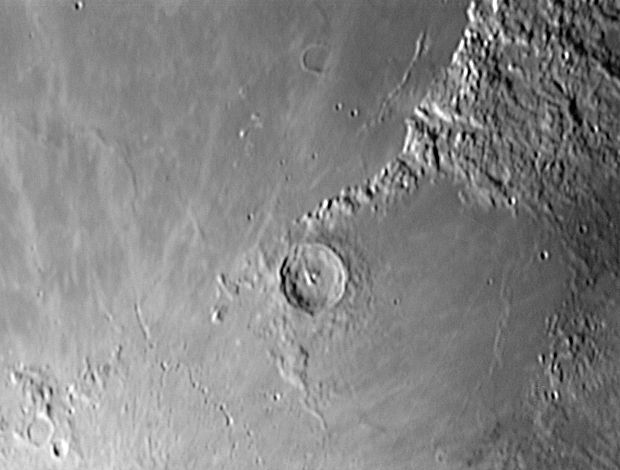
Eratosthenes is 60 Km in diameter and a relatively young crater, at between 1,000 and 3,000 million years. It is some 3,600 metres deep and lies on the southern shores of the Mare Imbrium at the southern end of the Apennine mountains.
The picture was taken with a ToUcam attached to my LX200 on 12th December 2006 when the Moon was 21.7 days old.
Date and Time: 12 December 2006 04:08 UT
Camera: ToUcam 740K
Telescope: LX200
Capture: K3CCDTools. High gamma, 1/25", 26% gain, 509 frames
Processing: Registax. 5 alignment points, 391 frames stacked. Wavelet 1-2 = 10, contrast 140
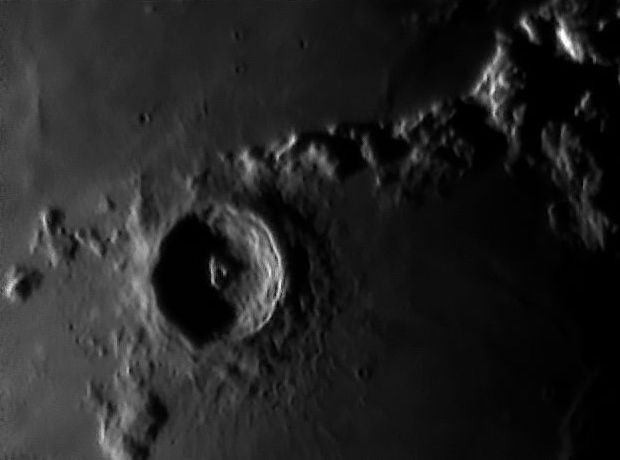
This close-up view of the crater was taken using my ×2 lens on a night of unusually steady seeing. I have used FocusMagic to enhance the picture (for more on this see here).
The picture was taken on 22 October 2008 when the Moon was 22.0 days old.
Date and Time: 22 October 2008 05:56 UT
Camera: ToUcam 740K and Neodymium filter
Telescope: LX200 with ×2 teleconverter lens
Capture: K3CCDTools. Low gamma, 1/33", 59% gain, 704 frames
Processing: Registax. 45 frames stacked. Gaussian wavelet 1 = 5, 2-6 = -5, step = 0
Focus Magic 10, 100 at ×2 and 3, 50 at ×1
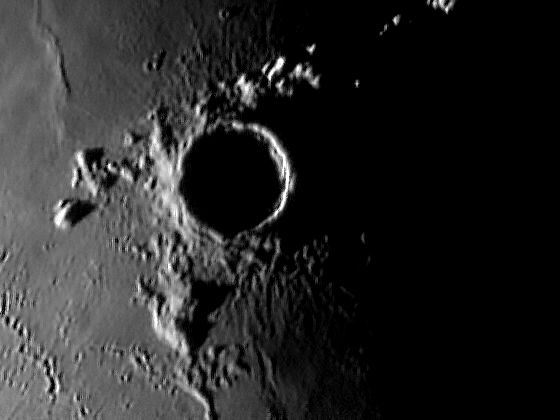
This close-up view was taken at sunset on this part of the Moon. Eratosthenes itself is almost entirely in shadow, but the low angle of the Sun brings out the mountainous areas created, no doubt, by the material ejected by the impact that formed the crater. In particular are the two mountains to the south of Eritosthenes. As far as I can ascertain they have no names, but NASA's Lunar Astronomical Chart LAC58 of this area indicates that the more-southerly peak has an elevation of 970 metres and the shadows in this picture seem to imply that the peak just to its north is higher.
A mosaic containing both Eratosthenes and Copernicus, taken the same night, can be seen here.
The picture was taken with a ToUcam attached to my LX200 with a ×2 adaptor lens at 03:31 UT on 7th October 2004 when the Moon was 22.8 days old.
Date and Time: 7th October 2004 03:31 UT
Camera: ToUcam 740K
Telescope: LX200 with ×2 lens
Capture: K3CCDTools. High gamma, 1/33", 32% gain, 437 frames
Processing: Registax. 110 frames stacked. Wavelet 1-3 = 10 Brightness -20
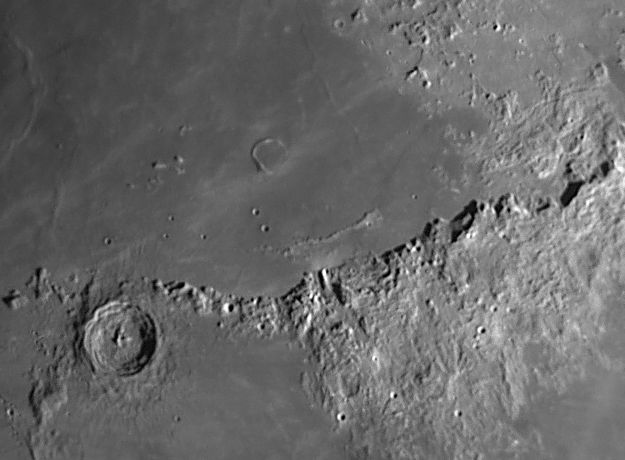
This is much the same view of this area as in the first picture on this page but taken with a DMK monochrome camera and much earlier in the lunar day. This picture is one of a set of 5 that form a mosaic from Copernicus along the Apennines to the Caucases, which may be seen here.
The scale markers are approximately 100 Km north and west.
The picture was taken with a DMK camera attached to my LX200 at 19:03 UT on 27th December 2017 when the Moon was 8.8 days old.
Lunar Phase: 72.3°
Colongitude: 24.7°
Libration: +6° 56' in latitude, -7° 49' in longitude
Date and Time: 27th December 2017 19:07 UT
Camera: DMK 21AF04
Telescope: LX200 with ADC (Atmospheric Dispersion Corrector)
Capture: ICCapture. 1/500", gain 741, 1795 frames
Processing: Registax6. 26 alignment points, 100 frames stacked per point. Wavelet 1-2 = 5 gamma 1.4
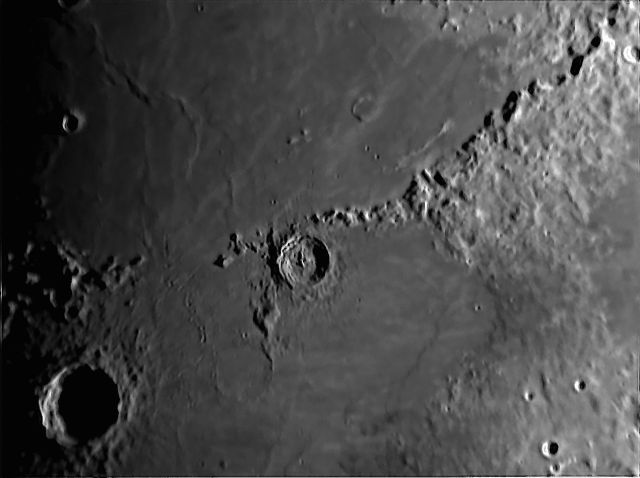
This is much the same view of this area as above and taken at almost the same phase. This one was taken using the same camera but attached to my ETX125 without the ADC. It is a reduction of the full-sized image which was made using the drizzle technique in Registax and may be seen here or by clicking on the image. (Use the Back button to return here.) The drizzling technique enables me to enlarge the picture ×2 with little or no loss of sharpness, so smaller details are easier to see. The omission of the ADC was a mistake which I have tried to correct (fairly successfully, I think) by using the motion-blur feature of Focus Magic.
The shorter focal length of the ETX has resulted in a slightly smaller-scale picture which has enabled me to include Copernicus which is right on the sunrise terminator, and you can see how the Sun is just catching the peaks of the western rim.
The scale markers are approximately 100 Km north and west.
The picture was taken with a DMK camera attached to my LX200 at 19:03 UT on 27th December 2017 when the Moon was 9.0 days old.
Below I show a comparison of my image of Eratosthenes and one from the Lunar Reconnisance Orbiter to the same scale.
Lunar Phase: 70.9°
Colongitude: 22.1°
Libration: -1° 48' in latitude, -3° 1' in longitude
Date and Time: 18th July 2021 21:29 UT
Camera: DMK 21AF04
Telescope: ETX125
Capture: ICCapture. 1/23", gain 663, 3600 frames
Processing: Registax5. 3340 frames stacked with drizzling (50%), wavelets 1-3 = 30. Focus Magic 7, gamma 1.3, Focus Magic 270,3

On the left is Eratosthenes cut from the full-sized version of my image above, and on the right is a picture from the LRO to the same scale. Comparisons are not entirely fair in that the LRO images are all taken at high Sun so that few shadows are present, and mine was taken when the Sun was low in the eastern sky. I have enhanced the LRO image with the same refocus parameter as I did mine even though there may be little justification to do so. I have also increased the gamma to 1.3 the same.
Careful comparison may show processing artifacts in my image, but the comparison does show that remarkably accurate pictures can be obtained by an amateur with simple equipment and no very expensive software. (As far as I remember the telescope was about £1000, the camera £250, the laptop computer £150, and Focus Magic was £30. Registax is free.)
Home Back to NW Quadrant